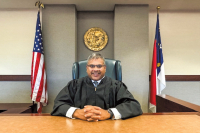Jackson law enforcement navigates new age of police video

On Aug. 9, 2014, an encounter between Officer Darren Wilson and 18-year-old Michael Brown on the streets of Ferguson, Missouri, left Brown dead and the entire nation in the midst of a riotous public debate over whether the shooting was a product of racism or self-defense.
Over in tiny Sylva, North Carolina, Police Chief Davis Woodard didn’t take long to determine how the incident would affect his department.
“We had body cameras I think by Sept. 6,” he said.
The officers who shot Brown weren’t wearing body cameras, making it harder for courts to ferret out exactly how the encounter had transpired. After Brown’s death, Woodard was certain that it wouldn’t be long before the U.S. Department of Justice made body cameras mandatory — but that hasn’t happened. However, Woodard said his officers are glad to have them in the department. On a practical basis, the cameras assist officers when writing reports and compiling evidence. They also provide a form of protection to cops and citizens alike.
“I think it makes them (citizens) maybe cooperate a little bit more, because they know if they choose not to cooperate, any of their actions are going to be recorded, whether it be good or bad,” Woodard said. “It also vice versa for the officer makes them step up their game a little bit too, because they know their actions are going to be recorded as well.”
Initially, Sylva purchased five body cameras — one for each officer on shift at a given time. Now, each officer has their own camera, a total of 15 costing $800 apiece. The department also has 10 in-car cameras, which cost $5,000 apiece. There’s also a $600 annual cost for storage. The hard drive costs $260. Though grants paid for some of the equipment, the town bought most of it. The total cost — grants included — of $62,300, plus the annual storage cost, is a significant portion of the town’s $3.6 million general fund, of which $1.2 million goes to the police department.
Related Items
Evidence collection versus officer protection
The Western Carolina University Police Department, while smaller than the Sylva Police Department, has had body cameras for a bit longer — the department got its first ones in 2008 and adopted the current system in 2014.
“Our primary thought on them when we first started using them was to capture what we’re seeing as evidence in court, that kind of thing,” said Police Chief Ernie Hudson. “And that’s still the primary purpose.”
However, he cautions, camera footage should never be taken as standalone evidence. It shows only one perspective, and doesn’t typically capture the entire context of what’s happening. Camera evidence is used in court only when the officer who captured it is present to testify.
For Major Shannon Queen of the Jackson County Sheriff’s Department, officer protection should be the primary use of police video, not evidence. The videos — taken from the vantage point of the officer’s chest or the unchanging perspective of his car — don’t show the whole picture. Relying too heavily on them as evidence can lead to incorrect conclusions.
For example, a pair of police videos in the 2003 case of Marquise Hudspeth shows two different angles on an incident that left Hudspeth dead after police fired eight shots into his back. From one angle, it appears that police officers chase down and shoot at a man who is simply walking away from them. Another angle shows Hudspeth brandishing a metal object, which resembles a gun in the video but turned out to be merely a cell phone. The case was hotly contested at the time, but the U.S. Justice Department eventually cleared the officers involved of any wrongdoing.
Police cameras have been around for a while, with dash cams debuting in the 1990s and body cameras coming around more recently, in the early 2000s, though their use surged after the Ferguson case. But the laws are just starting to catch up with current technology. According to Queen, this lag is the reason that the Jackson Sheriff’s Department doesn’t currently have body cameras, using only dash cameras instead.
“We’re kind of letting the rest of the country figure out what’s best practice with them so we don’t waste taxpayer money here,” Queen said.
Needed guidance
Neither Queen, Davis or Hudson could recall any instances of police video footage being requested by the public, but a high-profile police shooting in Charlotte last year thrust the issues surrounding release of such videos into the public eye.
Just months before the September shooting, the legislature had passed a law laying out explicit protocol for releasing and retaining any such footage. The July 2016 law went into effect Oct. 1 and allows law enforcement agencies to get rid of any video that is not part of a case file after 30 days. It also requires citizens requesting public release of a video to obtain a court order first. Obtaining a court order involves paying a $200 court filing fee.
Agencies in Jackson County have not yet had to put the part of the law involving release of videos into practice. However, Queen, Davis and Hudson all have a favorable impression of the law.
“It provides clear guidance, and I think clear guidance is all we ever asked for,” Queen said.
Before, the question of whether or not to release a video was left to the discretion of the individual agency, which would have to determine — without any clear legal guidelines — whether release would harm an ongoing investigation or violate someone’s privacy. While discretion is a great thing, Hudson said, the issues surrounding portable video technologies are so new that stronger guidance is welcome.
On the one hand, public documents are citizens’ check on how well government agencies are serving them. Did the officer fire cold-blooded shots into an unarmed man, or was he acting in self-defense against a gun-brandishing criminal?
On the other hand, officers often encounter people in their weakest, most vulnerable moments. How would it change law enforcement if someone calling 911 to report a sexual assault had to worry about the video someday making it on YouTube?
“Would that have a chilling effect on people reporting crimes?” Hudson asked. “And I think that’s a valid concern.”
“I see everybody’s point in this one, actually,” Queen added. It’s a fine line, balancing the public’s right to know with the victim’s right to privacy and the agency’s need to conduct a fair investigation.
The new law may not be perfect, Hudson acknowledged. One could argue, for example, that requiring a $200 court filing fee to request a video might be too high a barrier. But he believes it’s a definite improvement over what’s come before.
“Like any statute, there may be a time when they fine-tune it for various reasons, and the courts may give further direction,” Hudson said. “But my basic thought on this is at least this is a good start and gives us all something to work with.”













